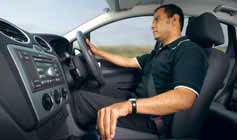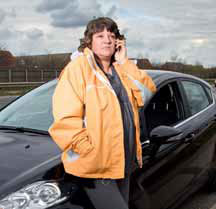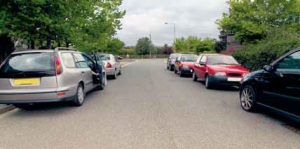Attitude
Contents
No matter how fast, expensive or efficient your vehicle is, it’s you, the driver, who determines whether it’s a safe means of transport.
Being a good driver doesn’t mean being a perfect driver – in fact, it’s very doubtful whether a perfect driver exists. A good driver is somebody who knows that they can always get better and is willing to make the effort.
With experience your practical skill will improve, but that alone won’t make you a good driver. To achieve that goal, you’ll also need to take responsibility for the way you approach driving. You need to develop your ability to
- concentrate and not allow yourself to be distracted
- scan the road ahead of you and learn to anticipate risky situations
- be patient with other road users
- understand your own state of mind and health, and how they may affect your driving
- have confidence in your abilities.
Together, these qualities make up what’s generally known as the driver’s attitude. It’s your attitude, together with personal characteristics such as mood, emotional state, and levels of fatigue and stress, that will affect how you behave on the road.
There’s a lot of enjoyment and satisfaction to be gained from showing not only your skill and ability but also courtesy and consideration to those around you.
Developing a safe and responsible attitude and adopting ‘good’ behaviour will come more easily to some drivers than to others. But these qualities are so important to safe driving that it’s vital for every driver to make the effort to keep working on them. The best drivers are always trying to improve their skills. Even when they’ve been driving for years, they know that there’s always something new to learn.
Responsibility
As a responsible driver, you must always be concerned for the safety of • yourself
- your passengers
- all other road users.
Yourself
See the information on health later in this section for more about your own safety.
Your passengers
Be aware of your passengers’ needs. For example, they may have mobility problems or be suffering from an illness that might need additional attention.
Also, make sure you understand your responsibilities regarding your passengers’ use of seat belts.
Other road users
Be tolerant; remember that everyone is entitled to use the road. This may mean making allowances for other road users, particularly the most vulnerable, such as
- children and older people
- people with disabilities
- cyclists and motorcyclists
- people in charge of animals.
Look around you and plan your actions well ahead to avoid causing danger or inconvenience. That way, you can avoid the need to act hastily.
Recognise your own limitations and those of other people.
Concentration
To be able to drive safely in today’s traffic conditions, you must concentrate fully at all times.
If you let your mind wander, even for a moment, the risk of making a mistake increases – and mistakes can lead to incidents.
Avoid driving if you’re feeling tired or unwell
- distracted in any way
- upset or annoyed
- under a lot of mental or emotional pressure.
Concentration is the key to anticipation and is helped by having
- good vision
- good hearing
- good health
- self-awareness.
If you have any in-vehicle technology such as a satellite navigation (sat-nav) system, don’t let it distract you from driving. Keep any visual or manual interaction with the system to an absolute minimum. You should find an appropriate, safe and legal place to stop before making any adjustments.
Before you set out
- turn your phone off, put it in silent mode or put it out of reach. That way, you won’t be tempted to make or answer phone calls, read or reply to texts, play games or use social media
- if you’re using a sat-nav, set your destination and make sure the device doesn’t block your view.
While on the move don’t
- use your phone for calls, texting or social media
- look at road maps, and only look at your sat-nav very briefly
- get distracted by tuning the radio, changing CDs or using MP3 players
- let conversation take your attention away from the road (an argument with your passengers can be particularly distracting)
- listen to loud music or use headphones of any kind, as these can mask other sounds
- be distracted by eating, drinking, smoking or vaping.
In addition, don’t
- stick non-essential stickers on the windows of your vehicle, as they can restrict your view
- hang objects (eg dolls, dice) where they might distract you and restrict your view.
Passengers
Passengers can be a major source of distraction if they’re
- talking to you
- using a mobile phone
- behaving irresponsibly.
Those who drive with young children in the vehicle may face increased distractions while driving. Preparation and planning are especially important.It’s sensible to come up with ways to cope with situations that may occur. For example, make sure that small children have enough to occupy them during a journey, so they’re less likely to get bored and cry.
Mobile phones
Driving requires all of your attention, all of the time.
You MUST NOT use a hand-held mobile phone or similar device when driving, except to call 999 or 112 in a genuine emergency when it’s unsafe or impractical to stop.
Using any phone or microphone, even if it’s hands-free, can take your attention off the road. It’s far safer not to use any phone while driving.
Let your incoming calls go to voicemail and stop before checking your messages. Likewise, if you need to make a call, find a safe place to stop first.
These rules apply even if you’re not driving, but are supervising a learner driver.
Anticipation
Anticipation in driving means planning well ahead and being prepared to take early action. With experience it should become an instinctive part of your driving.
You need to continually question the actions of other road users.
If you plan ahead and try to anticipate the actions of others, you can
- avoid the need for a sudden reaction
- maintain a comfortable safety margin
- prevent some hazards from developing
- save fuel by anticipating situations early. Braking late and heavily, then accelerating as the situation improves, increases fuel consumption.
Take early action in response to those hazards that do develop.
Anticipation and good planning are essential to developing defensive driving techniques (see section 10).
Patience
If you’re upset by the bad behaviour of another driver, try not to react. If necessary, slow down to calm yourself, even if you feel like making a more aggressive response. Consider stopping to take a break. While your brain is processing strong emotions, such as anger, your attention can be taken away from driving tasks. As a result, your powers of concentration, anticipation and observation are likely to be much reduced. This will make a road traffic incident much more likely.
We all make mistakes from time to time, so be prepared to make allowances for someone else’s mistakes.
Do
- keep calm
- show restraint
- use sound judgement.
Don’t
- drive in an aggressive or competitive way
- use aggressive language or gestures
- try to teach another road user a lesson, even if they’ve caused you inconvenience.
Learner drivers
Be patient if the vehicle ahead of you is being driven by a learner. They may not be as skilful at anticipating and responding to events as a more experienced driver.
Don’t
- drive up close behind a learner, as this is intimidating and could cause them to panic
- show your impatience, for example by revving your engine, if the learner is slow to move off
- cut in sharply after overtaking.
Expect a learner to make mistakes. Allow for their mistakes and don’t give them a hard time. Learners may not take the action you expect. Remember that it may take them longer to do things. Don’t forget we were all learners once.
Drivers who have recently passed their test may be displaying a green P plate or other warning sign to alert others that they’re new drivers. Be patient and make allowances for their lack of experience.
Read more about learner drivers later in this section.
Older drivers
Although they have more driving experience, older drivers may have slower reactions than younger drivers. Make allowances for this.
Confidence
Confidence is part of a driver’s attitude and is closely related to
- skill
- judgement
- experience.
Confidence levels are likely to change throughout a driver’s life. Many drivers begin with a relatively high level of confidence in their ability, but after six months their confidence is often much lower. Experiences such as being involved in an incident can have a negative impact on a driver’s confidence.
Overconfidence can occur when a driver overestimates their abilities and can lead to
- unsafe driving behaviour
- risk taking
- traffic and speed violations.
It’s important to assess your driving ability regularly. Many people think they’re better drivers than they really are, so it’s important to be honest with yourself and work on any areas you think could be improved. Many driving instructors offer refresher lessons for nervous drivers who would like to build their confidence.
